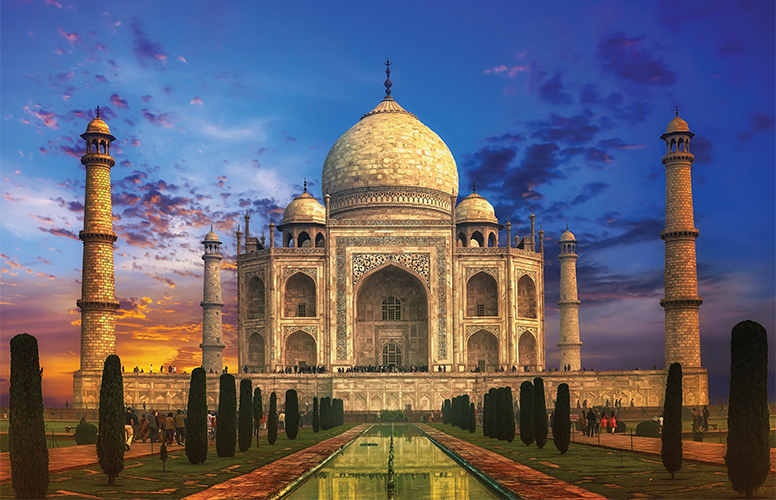Drawn by a fresh way of thinking by the Indian government, HVAC manufacturers in the Middle East are eyeing the possibility of a greater presence in the country.

In a case of the early bird trying to get the worm, UAE-headquartered Unigulf Air Conditioning Industries participated in Acrex 2016, the largest HVACR exhibition in the Indian Subcontinent, which took place from February 25 to 27, in Mumbai. As Rajesh Kane, who works as Production Manager at the company, explains, Unigulf went to the show to draw attention to the company’s offering of pre-insulated ducting systems. Such ducting solutions, he adds, have not yet gained as much traction in India as they logically ought to have.
Logically, because in Kane’s view, pre-insulated ducting systems score heavily over galvanised iron (GI) systems, as they take considerably less time to install, giving a cost advantage to the contractor. Also, they weigh considerably less – they are one-third the weight of steel – which means they reduce the overall weight of the building, thus subjecting the structure to lesser stress.
Another UAE-headquartered company, S.K.M Air Conditioning also went to the show, because the company wanted to explore the possibility of drawing attention to its commercial air conditioning solutions, especially for the oil and gas sector in India. “We have a major share in oil and gas in the UAE and want to enter the market in India,” says Asim Hashmi, Sales Director (Applied) at S.K.M.
All the manufacturers – be it Daikin, UTC Carrier, Hitachi or Mitsubishi – are either coming forward or are investing into their existing factories
Companies like Unigulf and S.K.M are eyeing India with a lot of interest. With the Narendra Modi Government perceived as being more dynamic than its predecessor, there is a positive buzz about the country. Add to the optimism the evident population-driven demand for air conditioning, ventilation and refrigeration solutions, and a picture emerges of a country pregnant with opportunities. As Hashmi puts it: “Air conditioning is becoming a necessity in India, and the majority of the population has not got air conditioning. Plus, there is the industrial growth. The government has announced 7-8% growth, which is an aggressive rate. And they are encouraging foreign investors, so there is construction.” The Subcontinent, Hashmi says, is huge, and people are multiplying growth in a short period of time.
Manish Hira, the Director of another UAE-headquartered manufacturer, Hira Industries, at the exhibition, echoes Hashmi’s sentiments when he says: “India is being seen as the next China. The government is pushing the ‘Make in India’ initiative. India is being perceived as the next big thing.”
The Make in India initiative is garnering global eyeballs. A pet project of the Modi Government, the manufacturing and industrial sector worldwide is looking at the programme with a lot of intent. Pankaj R Dharkar, President of Pankaj Dharkar & Associates, an India-headquartered MEP and Green Building consultancy firm, talks of how the programme is inspiring the Indian engineering industry to invest in R&D and in setting up manufacturing facilities. He says it is equally inspiring a large number of multinational companies to set up plants and make investments in India. “I can see a lot of positive energy flowing,” Dharkar says. “As a result of the programme, Indian consumers are going to get world-class products at much more reasonable costs. All the manufacturers – be it Daikin, UTC Carrier, Hitachi or Mitsubishi – are either coming forward or are investing into their existing factories.”
 The wind of optimism blowing through the country is so strong that talk of the global slowdown is met with some degree of scepticism. No doubt, there is a section of architects and MEP consultants, which has a wary eye on the roller-coaster nature of global markets and its impact on India in the form of a drop in prices, but largely speaking, the mood is buoyant, with many saying that they are loaded with projects. Says Dharkar: “In the last six months, I have seen lot of positivity. As a company, we have closed many orders. Maybe, I am one of those fortunate persons, but I can see that happening with many of our co-consultants, as well. And when consultants close jobs, it normally goes to contractors or suppliers in a matter of six months to a year’s time.”
The wind of optimism blowing through the country is so strong that talk of the global slowdown is met with some degree of scepticism. No doubt, there is a section of architects and MEP consultants, which has a wary eye on the roller-coaster nature of global markets and its impact on India in the form of a drop in prices, but largely speaking, the mood is buoyant, with many saying that they are loaded with projects. Says Dharkar: “In the last six months, I have seen lot of positivity. As a company, we have closed many orders. Maybe, I am one of those fortunate persons, but I can see that happening with many of our co-consultants, as well. And when consultants close jobs, it normally goes to contractors or suppliers in a matter of six months to a year’s time.”
Given the diversity in the HVACR industry, the growth is not uniform, though. On the residential side, there is an explosion of growth in the evaporative cooling market, says Varun Pahwa, the AVP – New Business Development of Bry-Air. In fact, so significant is the growth, he says, that there is a shift from an unorganised to an organised market structure in the evaporative cooling market. When it comes to the commercial sector, there has been a delay in old projects, owing to cash-flow issues. Additionally, there is reportedly very little in the pipeline in the forms of malls, new airports and office buildings that would be leased out. Nevertheless, there are opportunities for those that assiduously seek them out, including for those from the Middle East seeking a share of the market. In the view of insiders, like Pahwa, the commercial air side market is fairly saturated, but there are opportunities on the chiller side. It is a view echoed by Hashmi, who says S.K.M is keenly exploring the possibility of introducing its range of chillers and condensing units and also its avowed strength – rooftop packaged units – into India.
Pahwa sees the greatest number of opportunities in the industrial sector in India. “The industrial side, oil and gas and the manufacturing sector have picked up a lot faster than the commercial HVAC sector,” he says. “Refinery capacity is coming up in India. And I see a lot of activity in ship building, pharma and the food industry, which means a wider opening of doors for the suppliers of cold chain-related equipment. Middle East-based companies will be able to spot opportunities, if they have niche solutions.”
While the opportunities are there, India, just like any other country, also poses a lot of challenges for businesses looking to establish themselves on its soil, or to strengthen their presence. As Hira puts it, India is a very protective market, characterised by high duty charges. It is a tax-heavy environment, he says, and demands a lot of paperwork. “It is true India is being seen as the next big thing, he says. “However, if people think they can come in and expect phenomenal growth rates, it won’t happen immediately. It will perhaps take five years. You can’t come with a Middle East mentality, because things are different here.”
As a country, we have built only 10-20% of what we need to build
India is also a price-sensitive market. In the view of many of the industry insiders, the trick to succeeding as a manufacturer in India is to provide quality at costs that are affordable. The mantra for success, they say, is to make in India, develop in India, and source and price for India. “These are critically important points to remember,” says Barun Aggarwal, CEO of India-headquartered Breathe Easy Consultants. “Foreign prices will not work.”
In making his point, Aggarwal points to the examples of Trane and Daikin, two of the international brands with a strong presence in India. “Earlier, they were selling at Rs 100,000 (approximately USD 1,500) per tonne of air conditioning (TR),” he says. “Today, they are selling at Rs 35,000 (approximately USD 530) per tonne of air conditioning. Daikin has more than 50% share of the residential air conditioning market in India. Earlier, they had a very small share. So if you are ready to embrace India in the true sense of the word, you will succeed.”
Adding to Aggarwal’s words, Hira speaks of the critical importance of hiring local talent and establishing local infrastructure as a means to succeeding in India. Having local infrastructure, he says, is a vital aspect for businesses wanting to avoid the 28-30% import duty the Indian government imposes. That is precisely why Hira Industries in 2012 initiated proceedings for setting up factories in India. The proceedings included due diligence measures and scouting for a site reasonably close to a seaport. The company eventually chose the western Indian city of Pune, owing to its proximity to the port in Mumbai. In 2015, Hira Industries inaugurated two factories – a 60,000 square-foot facility to produce its Maico brand of ventilation systems, and a 100,000-square-foot facility to manufacture its Aerofoam brand of insulation solutions.
The 28-30% import duty that Hira refers to is in addition to the 12.5% value-added tax (VAT) that the government imposes. The total of the two is what those that do not have a factory in India have to contend with. This begs the question, ‘Would not Indian manufacturers have a tax advantage over those with facilities overseas?’ Not so, says Sanjiv Sachdeva, the Managing Director of Gulf Engineering System Solution (GESS), because manufacturers in India are required to pay excise duty and VAT, the total of which works out to be the same as the other tax regime. Hashmi says he does not find the tax structure in India to be adverse, even without a manufacturing facility in the country in the immediate term. “We shall be paying the same as the producers in India, if we take the equipment into the country in the name of the project owner,” he says. “You can open a letter of credit (LC) in the name of the owner.”
In the long term, S.K.M expects to establish a manufacturing facility in India, in the footsteps of the big MNCs. “We have taken note of JCI India Ltd and Daikin India Ltd and want to adopt that direction,” Hashmi says.
One thing is for certain – there is no mistaking the determination of S.K.M to enter the Indian market. As Aggarwal puts it, India is still very, very young, when it comes to the building sector. “As a country, we have built only 10-20% of what we need to build,” he says. “In the next 20 years, we are going to see four times the number of buildings we have in the country. So energy efficiency and indoor environmental quality (IEQ) related to air conditioning will constitute a critical demand.”
(The writer is the Editor of Climate Control Middle East and the Editorial Director & Associate Publisher of CPI Industry.)
Copyright © 2006-2025 - CPI Industry. All rights reserved.